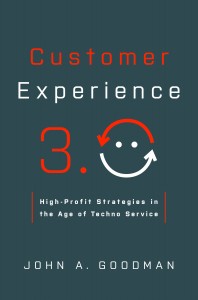Next week’s podcast is the 2nd part of Where Strategy and Customer Service Meet, Part 1 of 2 with John Goodman, Vice Chairman of Customer Care Measurement and Consulting (CCMC). If you missed the first part, I encourage to listen it was excellent. The 2nd part of podcast we move on to discuss parts of John’s new book and more about his pre-conference workshop on Sunday, October 6th WKSP01: Using the Voice of Multiple Customers (VoC) to Drive Quality: Be Easy to Do Business and Monday’s Session M04: Beyond the Buzzwords: Using Data to Enhance Loyalty and Service ROI at the ASQ 2013 Service Conference. On Tuesday afternoon, I have the honor to be presenting at the same conference, Session T06: Lean Service Design.
One of the questions from the upcoming podcast:
Joe: In your new book, I think you address something you call a Customer Experience Framework. Can you tell me what that is and more about your new book?
John Goodman:
“Yes, it’s called “Customer Experience 3.0”, and it will be out in the spring of 2014. What we’re basically doing is we’ve expanded on my previous basic framework by adding one more step. Ideally, you want to do the job right the first time. That’s where most organizations get into trouble because they define quality as we deliver the product according to specification. In most cases delivering the product according to specification has unpleasant surprises built into it simply because it’s miss-marketed or is complicated and nobody read the manual. Then, if the customer does have a problem, you need get the customer to the correct service function. We’ve created a new box called “Access”. Which isn’t you just need somebody there answering the phone. There’s a step ahead of that which is you need to motivate the customer to take the time to communicate with you.
This is the iceberg that I talked about where most customers we find no longer bother complaining or asking for assistance, simply because life is too short and it’s too busy. The most that do is go to your website. If they don’t find it in the first three clicks, they simply give up by not using that functionality in your product and continue to cuss you out while they’re not using it. So, the first step in access is saying we can only solve problems we know about, here’s how to communicate with us. Also allowing for the 20 something who won’t even call an 800 number, what you need to do is on your home page of your website have the 4 or 5 top issues that people are calling the service system about and right there when I go to the home page here are the 4 or 5 issues. “Oh yeah that’s the one that I am interested in”, and they get their answer without ever having to call you. If you’re smart, it’s a living list that this week’s list of five issues is based on the call you were getting last week in the contact center. So you’re proactively, preemptively educating the customer on how to stay out of trouble. This is what I call “Psychic Pizza” and I’ll come back to that in a couple of minutes. It’s basically ringing your doorbell and saying here is the answer to the question you were about to ask or the pizza you were about to order.
The third part of the box of the framework is the customer service system which again should preemptively provide service whenever possible. Amazon knows what you want to ask when they are shipping my book, so they send you the e-mail before you ever get around to it and that’s sort of delivering psychic pizza.
The fourth piece of the framework is a feedback loop, which is basically listening and learning. The big problem we find in most organizations is that you listen, but you don’t learn, and part of learning is not just fixing the issue but feeding it back to the customer, “Hey, we did the survey and here’s what we’ve heard and here’s what we’ve done about it.” We find that when you start feeding back to the customer with the issues you have identified based on their input the customer, number one feels you are a much better company, you care, and number two it’s: “Oh, you’re paying attention to this input? Well in that case here’s some more input.” We’ve actually seen that input goes up dramatically as you start feeding back to the customer base here’s what we’ve heard. That also applies to employees, we were working with one of the big technology companies and they were getting input from their employees, and when they started doing a monthly e-mail saying last month we got 1,200 pieces of feedback and here are the three of the biggest issues, and here’s what we are doing about it. The reaction was, “Oh, you were doing something about it? Well in that case here’s a bunch of stuff”, and we found that input went up by a factor of 20.”
John Goodman is Vice Chairman of Customer Care Measurement and Consulting (CCMC). CCMC’s customer satisfaction and loyalty surveys and analytics are used by leading Fortune 500 companies from every industry to produce a better ROI from their investments in customer experience. John has managed more than 1,000 separate customer service studies, including the White House sponsored evaluation of complaint handling practices in government and business and studies of word of mouth and the bottom-line impact of consumer education sponsored by Coca-Cola USA. The American Management Association published his book, “Strategic Customer Service”, in May, 2009.
